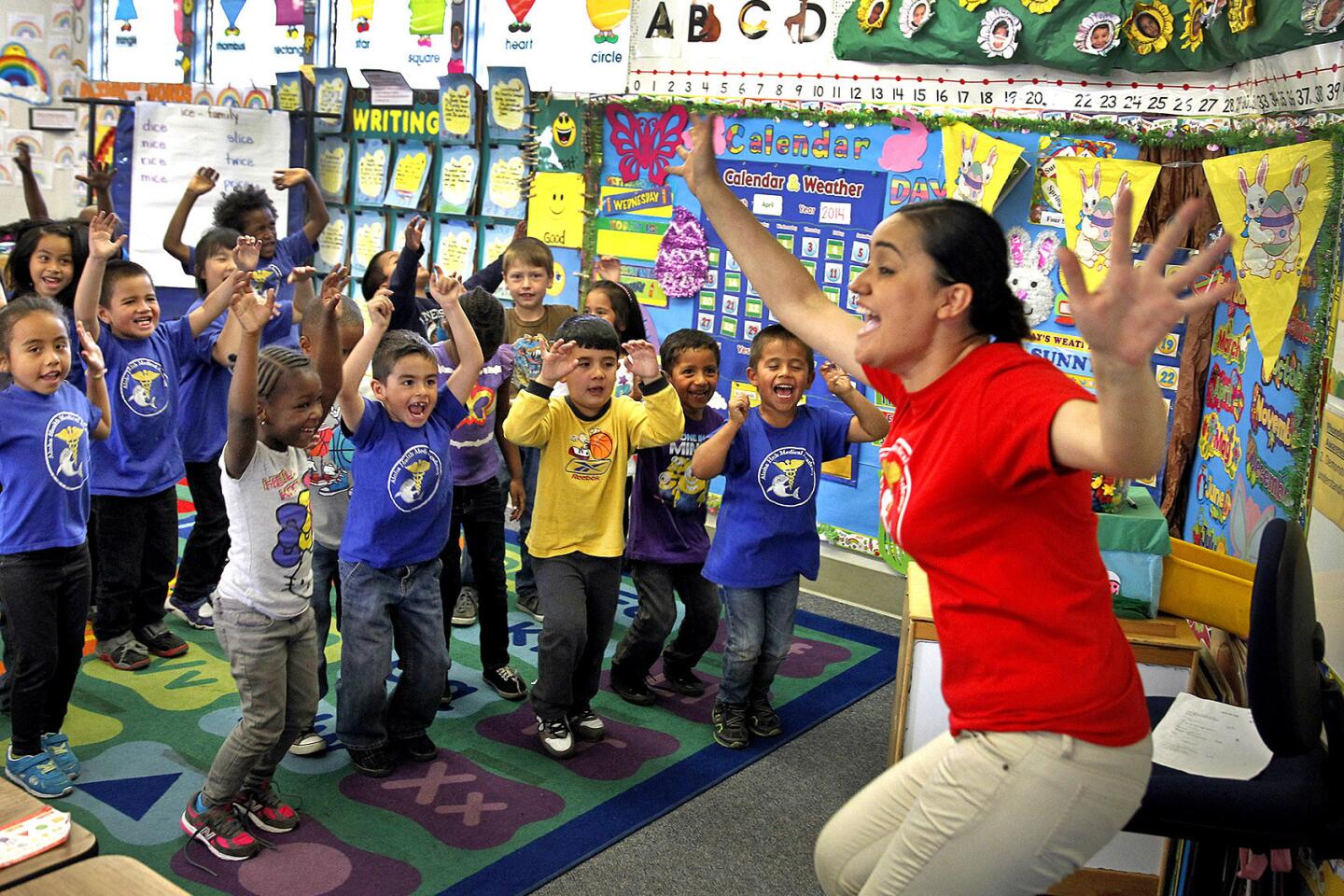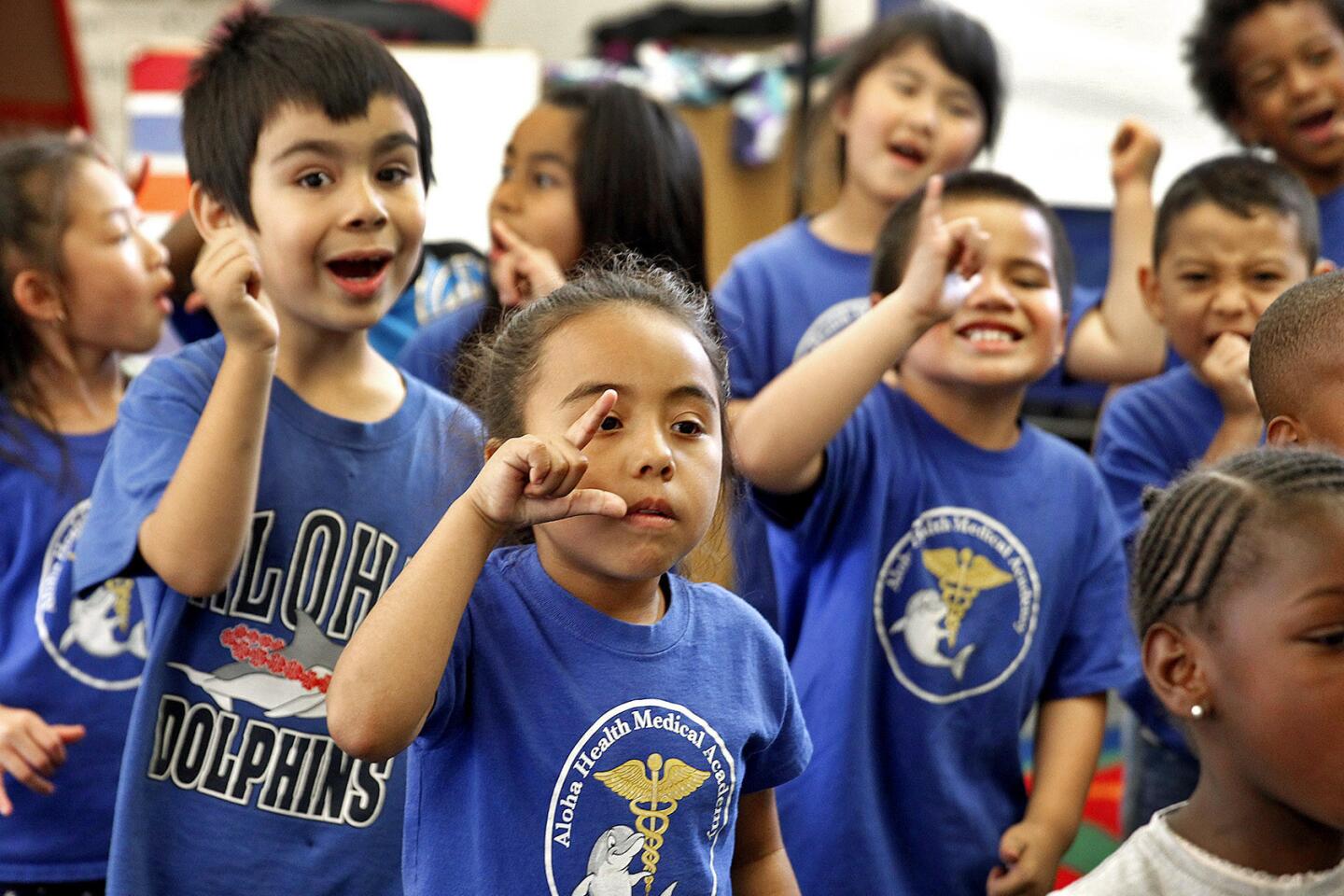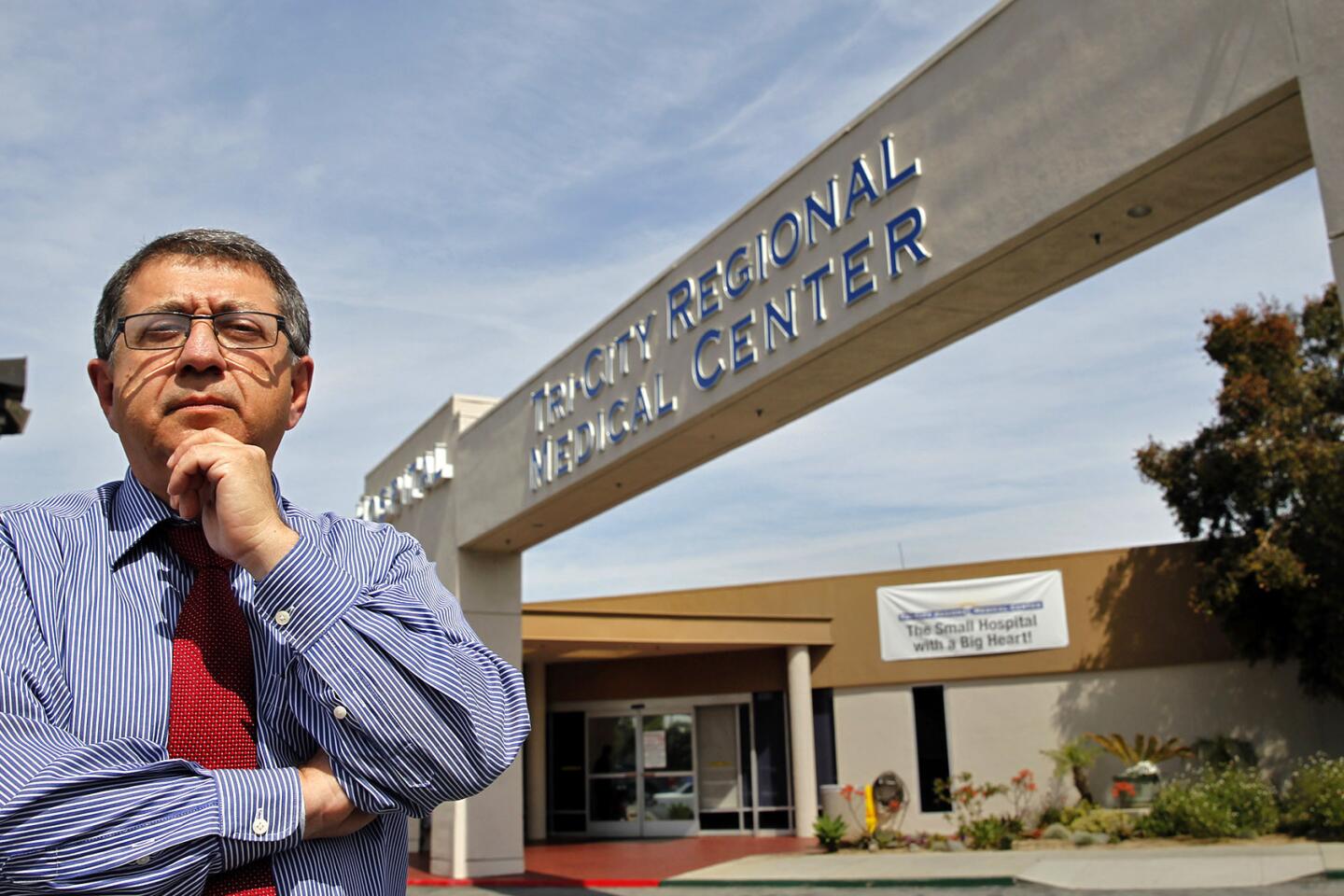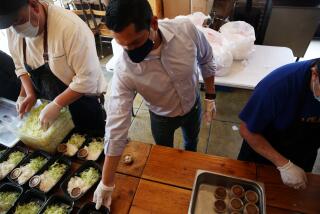Great Read: One man’s uphill fight to stem childhood obesity
A short walk from the fast-food drive-throughs, taco joints and doughnut shops lining Hawaiian Gardens’ palm-tree-dotted main drag, a classroom of energetic kindergartners begins a well-rehearsed routine.
Jutting their thumbs down and contorting their faces in theatrical frowns, the kids chant, “Soda is bad!”
“Doritos?” teacher Adriana Rosas calls out.
“No!” the kids yell, each making an “X” with their small arms.
Standing quietly to the side with his arms crossed, a short man in square-framed glasses smiles.
Alexander Khananashvili wrote these sing-alongs, which are heard in four elementary schools serving this blue-collar, predominantly Latino suburb east of Long Beach.
The tiniest city in Los Angeles County, Hawaiian Gardens would be easy to miss, but for the large electronic billboard on the 605 Freeway luring passersby to its casino. The town takes up less than a square mile. Nearly a quarter of its population lives below the poverty level.
But to Khananashvili, the city’s size offers an unusual opportunity. He sees a condensed and manageable space to test emerging theories that suggest keeping off extra pounds requires upending everyday food culture — at schools, in grocery stores and homes, at restaurants.
“The problem with obesity can be solved,” says Khananashvili, a self-styled community educator. “It’ll take years, but it can be solved.”
It’s been an unlikely journey for a physician who left Russia for an immigrant’s life in America 15 years ago and found success teaching the children of other immigrants how to improve their lives — even if that’s not always easy.
::
It all began with a chance meeting at a vending machine.
When Khananashvili immigrated to Los Angeles with his wife and two daughters, he didn’t have money to return to school here and get a doctor’s license. He didn’t know a word of English. He had to start over.
Now 57, Khananashvili describes how — like many arrivals from overseas — he was immediately struck by the large number of obese people in the United States.
“You cannot even compare,” he says, bugging out his eyes for effect. He became convinced the problem stemmed from an unhealthful eating environment.
Sensing an opportunity, Khananashvili launched a vending machine business that dispensed dried fruit and nuts, alongside chips and candy.
Dangling a bag of Cheetos between his fingertips, he says, “I don’t eat this crap.” Then he apologizes for the unusual breach of his European manners.
One day, while stocking a machine in Hawaiian Gardens City Hall, Khananashvili met then-Mayor Mike Gomez.
Gomez was seeking solutions to Hawaiian Gardens’ obesity problem. In a city of 14,000 residents, one in three kids were severely overweight, a rate 43% higher than the county average. Obese children face immediate medical problems, researchers say, as well as higher risks of heart disease, diabetes and cancer later in life.
“Unfortunately,” Gomez says, “I didn’t know how to bring it to the fore.”
Khananashvili did.
Though usually cheery and quick to laugh, he gets visibly frustrated when talking about the obesity epidemic. He braces himself to explain. Resting his elbows on his desk, he slips on his glasses. Then, showing a flair for drama, he clasps his hands in front of his face and closes his eyes.
“The problem is nobody cares about the problem,” he says.
He’s upset that there’s no governmental agency dedicated to fighting obesity on all fronts. He calls stand-alone attempts, like banning sodas from schools, “fairy tales.”
“It’s a huge problem that costs billions of dollars, and we don’t do anything about it,” he says.
As he and Gomez spoke, Khananashvili gradually convinced the mayor that getting kids in better shape required both community-wide change and parent education. The two became friends, and with Gomez’s help, Khananashvili began free lectures at City Hall on healthful eating. Eventually, he was hired by the local Tri-City Regional Medical Center to run its community health programs.
Last year, Khananashvili started Activate Hawaiian Gardens — a city and school district collaboration funded by the hospital — to teach nutrition classes to kindergartners’ parents.
Since then, his program has launched healthful cooking demonstrations on the city’s cable TV channel (with guides to finding the ingredients at the local Wal-Mart), gotten children singing the praises of whole-grain bread, changed the school lunch program and prompted the local Subway shop to incorporate his diet suggestions on its sandwich menu.
“To end the epidemic, you must work on society,” Khananashvili says. “The environment needs to change everywhere.”
::
Yolanda Solorzano was among more than 60 parents who attended Khananashvili’s morning classes at a local elementary school. In one typical session, she recalled, Khananashvili warned the class about their selection of tortillas.
Solorzano was skeptical. “We’re Latinos — we’re not about to give our tortillas up,” she says.
But Khananashvili brought in samples of low-salt, preservative-free tortillas, which required refrigeration. Solorzano says they tasted better and reminded her of the fresh, hand-made tortillas she ate growing up in Mexico. So she switched.
May Wang, a professor of community health sciences at UCLA, says that for immigrant families, “food is really one thing that people try to hang on to very much.” She says staple foods, like tortillas, are typically the hardest to give up.
Parents say the classes helped them make little changes to improve their diets, such as switching to low-fat milk and replacing red meat with fish. Many pledged to stop giving their kids soda, limit TV and computer time, and scrutinize nutrition facts as they select items at the market.
Khananashvili aims for simple adjustments in eating patterns, without boosting food bills, he explained recently over lunch, where he ordered salmon, steamed vegetables and green tea.
He says he’s seen improvement. Roughly 45% of 300 kindergartners in four participating elementary schools were obese or overweight before the program began, according to a report on the project written by Gomez and Khananashvili. A year later, Khananashvili says, parents who took the class saw an almost 4% reduction in their children’s body mass index — a measure based on weight and height.
Gomez, now a city councilman, called the results “amazing.”
Last year, First Lady Michelle Obama recognized Hawaiian Gardens for having one of the most comprehensive anti-obesity endeavors of any small city in the country.
::
Despite the successes, the program has encountered resistance in some quarters of the community and struggled to maintain its financial footing.
Several parents have objected to the dietary adjustments in the school lunch program, including adding more fruits and vegetables to the school menus, says Sophia Tse, board president of the ABC Unified School District, which includes Hawaiian Gardens.
“I get parent complaints about all the healthy food the kids don’t like … ‘They took the candy away! They took soda away!’ ” she says, adding that some parents have tried to get fast food delivered at school for their children.
Recently, the hospital in Hawaiian Gardens said it could no longer afford the $80,000 to $100,000 cost of the community program, a portion of which paid Khananashvili’s salary. He was laid off.
The city has stepped in with a $12,000-a-year consulting contract for Khananashvili to keep the program going and expand it to preschool classrooms, while they apply for grants to get more money. Khananashvili says that’s not enough to support himself, and he may soon have to step away from the project for a full-time job.
Lisa Simpson, a pediatrician and health-policy researcher, says the obstacles Hawaiian Gardens faces point to a larger problem encountered by community-based efforts to combat obesity over the long term.
“This is a story that I’ve heard more than once across the country,” says Simpson, president and CEO of AcademyHealth, a nonprofit research organization in Washington, D.C. “The passion and commitment of individuals help start something, and then we fall down when it comes to sustainability.”
Gomez is scrambling to find more money so Khananashvili can remain with the program in Hawaiian Gardens.
“I don’t want to give up,” Khananashvili says. “But on the other side, I have to survive.”
soumya.karlamangla@latimes.com
More to Read
Start your day right
Sign up for Essential California for news, features and recommendations from the L.A. Times and beyond in your inbox six days a week.
You may occasionally receive promotional content from the Los Angeles Times.











